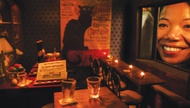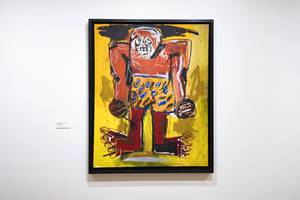
YASUAKI ONISHI: PERMEATING LANDSCAPE Through October 27; daily, 10 a.m.- 7 p.m.; $5-$10. Bellagio Gallery of Fine Art, 702-693-7871.
Polyurethane sheeting finally has its moment! That humble material, used by painters to prevent spills and builders to keep down dust, becomes a living, breathing colony of 12 jumbo blimpies in Yasuaki Onishi’s Permeating Landscape at the Bellagio Gallery of Fine Art.
The sheeting pulses, plops, floats, stretches and shimmies. One cylinder rises from its perch and hovers near the ceiling, catching the light and throbbing like an alien bio-morph. Another gives up the ghost, deflates and rests flat and forsaken on the floor, a sad and wrinkled reminder of its former buoyant self. Then a gently whirring motor fans air into the casing and it rises again to bob among fellow blobs, seemingly animate and weirdly calming. Watching these things is almost as good as setting the meditation timer to an hourlong session.
The polyurethane “Vertical Volume” isn’t the only disarming sculpture created by BGFA’s current artist-in-residence. In the gallery’s second room, Onishi has installed a site-specific piece composed entirely of shiny brass wires, a delicate tissue of air and sparkle. Hanging from the ceiling like a neural net, the draped sculpture encourages viewers to enter an inverted landscape of peaks, troughs and crevasses. The lines and contours of the brass wires seemingly manifest planes, the void between filaments easily filling with the mind’s irascible longing for shape and mass. Instead of emptiness, the imagination perceives a mountainous landscape that isn’t there—or an organic network of intricate connections claimed by a superior organism promoting mind-meld.
Onishi’s Permeating Landscape show is premised on making the invisible visible—whether by inflating semitransparent polyurethane sacking or by suspending a suggestive wiry mesh. Rather than perpetuating the touchstones of Western sculpture, such as weight and volume, Onishi’s work engages an emptiness that’s anything but empty.
Instead of monumental figurative bronzes by Rodin or Picasso that conceal a hollow core, Onishi inverts the protocol, beginning with a disguised emptiness and materializing the form. Attention to invisibility, and to related terms of emptiness and absence, points toward the cultural influence of Buddhist and Shinto religions. Westerners don’t often get the Oneness of all things—we’re too focused on individual parts—let alone how negative space is really very full.
The 36 graphic works in the show extend Onishi’s spectral concerns to 2D media. The monochromatic “Plates of Pressures” (2019) is a tour de force of pattern and texture, in which Onishi wields a glue gun like a paintbrush, stroking metallic powder to reveal a palimpsest of snail trails or a whirling silicon vortex. In “Darkness Thing” and “Grind and Roll” (2015), Onishi moves a steel frame from foreground to background, grinding it in a long exposure so that the sparks become a fiery portal of infinite reckoning surrounded by eerie fluorescent vegetation. The earlier polychromic series, “Drawing” (2007), is less successful, veering away from an uncanny intuition for materials toward the pleasant pursuits of Japanese Pop, the bright pastel colors siphoning away oomph.
Onishi is at his best when he cues what isn’t there. When it comes to manifesting invisibility, he’s a master.






